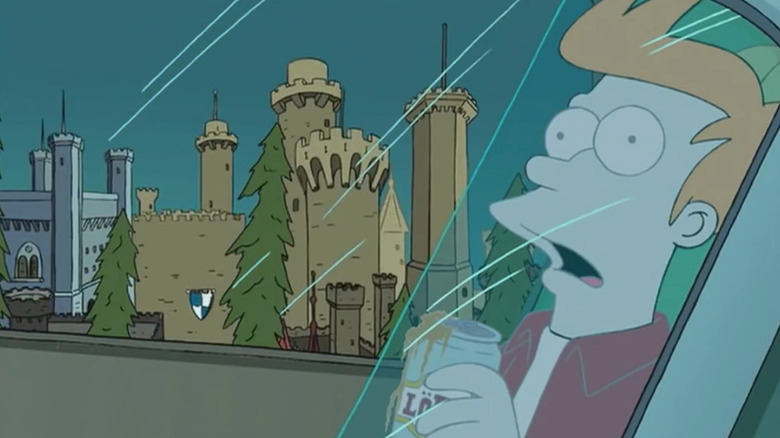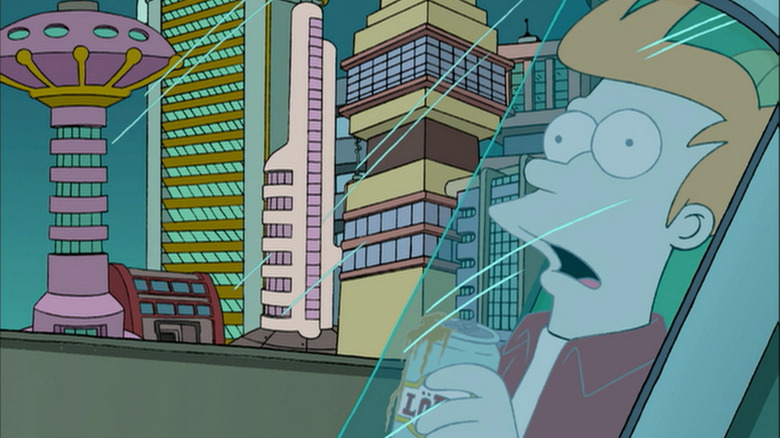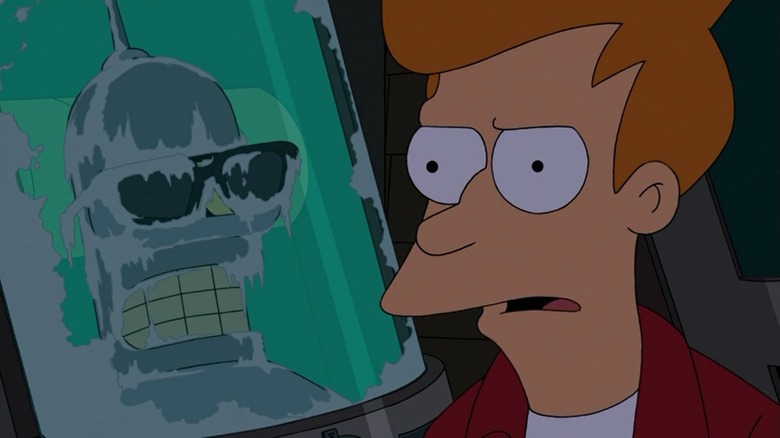Futurama Animators Are Faced With The Same Challenge Every Couple Of Seasons
"Space Pilot 3000," the first episode of Matt Groening's and David X. Cohen's sci-fi sitcom "Futurama," sees the bumbling, directionless Fry (Billy West) delivering a pizza to a cryogenics laboratory on New Year's Eve, 1999. While at the facility, Fry notices that his delivery is for someone named "I.C. Wiener," and he figures he has been pranked. As the world counts down to the year 2000 outside, Fry eats the pizza and cracks open a beer in solitude, toasting another lousy millennium. He then falls backward in a chair and tumbles into an open cryogenics pod. It slams shut and automatically activates. Fry remains frozen for 1,000 years.
Throughout "Futurama," the characters would periodically return to the cryogenics lab where Fry was frozen to find others from Fry's time being freshly resurrected (e.g. Pauly Shore). The cryogenic freeing was a handy way to get 20th-century characters into the year 3000 without having to worry about contrived time travel technologies. Introducing reusable time travel seemed too complicated for a lighthearted show like "Futurama," and actual time machines wouldn't be introduced until much later in the show.
The day Fry was frozen, however, was revisited frequently. In some stories, that fateful New Year's Eve was visited by time travelers. In others, some very long-lived characters happened to be lurking in the shadows, waiting to re-emerge a millennium later. Most often, the series would feature flashbacks to 1999 allowing audiences to see Fry's family and backstory.
For the animators, though, this means that the pilot episode of "Futurama" has to be re-created every few years. Talking to the AV Club in 2013, David X. Cohen acknowledged the challenges in re-animating an old episode, especially given that the show's style had continued to improve.
The many origin stories
The AV Club asked Cohen specifically about the episode "Game of Tones" from 2013, which saw the Professor (West) using a complex virtual reality machine to shunt Fry's consciousness into a memory realm, allowing him to explore his memories of 1999 without having to time travel. That episode saw Fry once again cryogenically frozen. After 13 years and several "Futurama" movies, though, the series had clearly evolved, animation had become slicker, and actors had settled on more permanent versions of their voices. The dilemma: Does one recreate the 1999 episode as accurately as possible — back before they were being produced in high definition — or does one change it to match the technology at hand?
Cohen said he changed it, but only a tad:
"You know, we've done that in something like four episodes now, where we've revisited the moment where Fry got frozen. And each time, we say, 'We want to match it up with what we did the first time.' And the animators say, 'Well, let's make it look a little bit better!' You can't help but bump it up a notch. That's always the challenge for the animators. Remember those designs that have been sitting in a drawer for 13 years? But now it's in high-definition. That's a particular challenge we put on our animators about once every two seasons."
Fry's freezing was previously depicted in 2000's "Anthology of Interest I" and 2003's "The Why of Fry," and was explored heavily in the movie "Bender's Big Score" (2007). It also made a cameo in the 2010 time-travel episode "The Late Philip J. Fry." Cohen wasn't kidding.
The history of Futurama's animation
From the start and to this day, "Futurama" mostly features hand-drawn characters and hand-painted backgrounds. CGI is used for certain special effects, flying space ships, spatial phenomenon, crowd scenes, and other effects like snow and rain. Occasionally, a character will be rendered in CGI, but only when they are being incorporated into an effect. (Scott Vanzo once authored a very detailed rundown of the animation process on "Futurama," and how he and his company, Rough Draft Studios, exploit as many tools as they can.)
It wasn't until "Bender's Big Score" was in production in 2006 that "Futurama" began producing its animation in high definition. This is why image searches for early "Futurama" episodes look so fuzzy and murky, while newer episodes are clear and clean. It was also when the series went from a 1.37:1 Academy standard aspect ratio to the now more common 1.85:1 that fits snugly into a standard 16:9 TV set. The update required the showrunners to update the theme sequence as well, forcing them to re-render the entire scene.
So, yes, updating the pilot episode was a technical concern. When one can have high-definition animation, more consistent line thickness, and fewer photographic artifacts on the screen, a scene is going to look far, far different than it was when it was mostly hand-drawn. It seems Cohen's initial instincts were toward historical preservation, but his animators were wise enough to encourage slight updates each time.
"Futurama" is back, so there's every reason to believe we'll eventually party like it's 1999 again.


